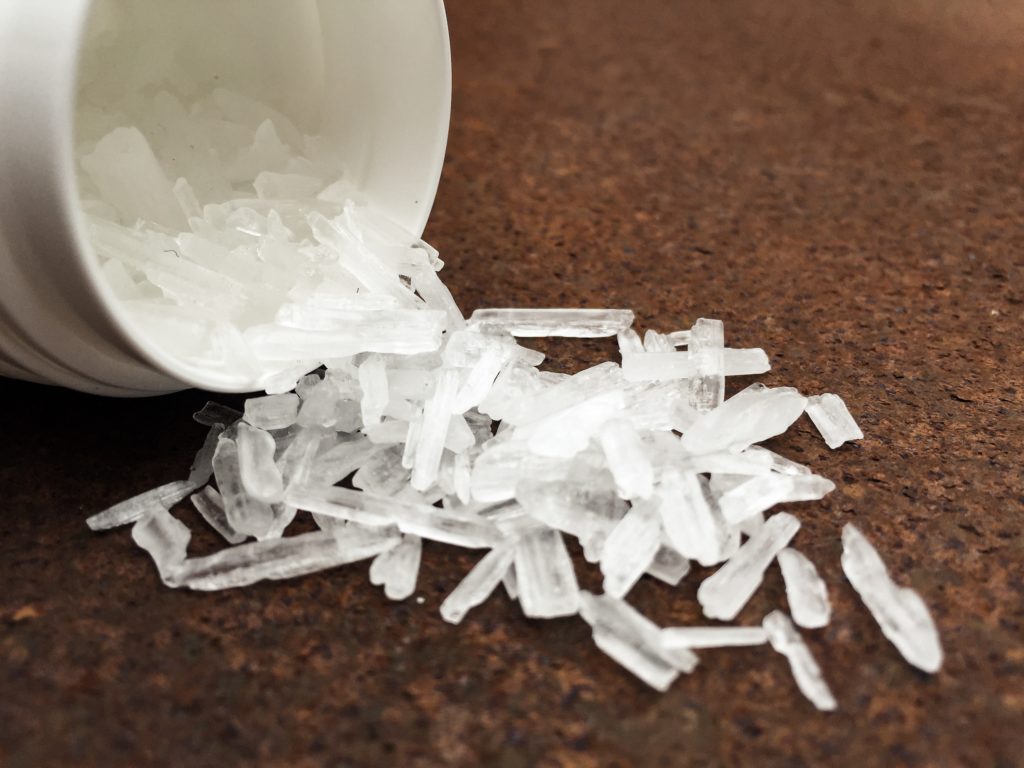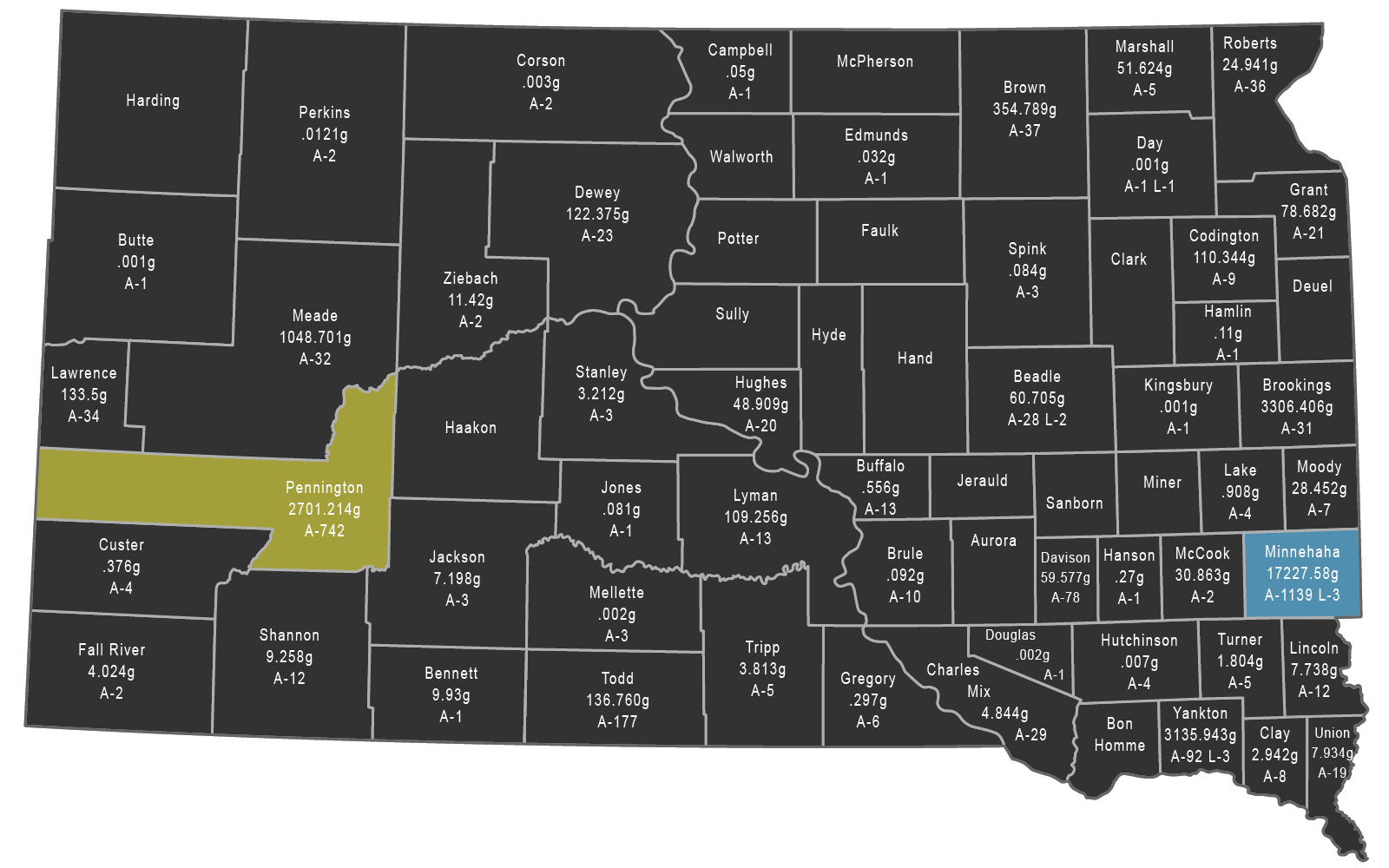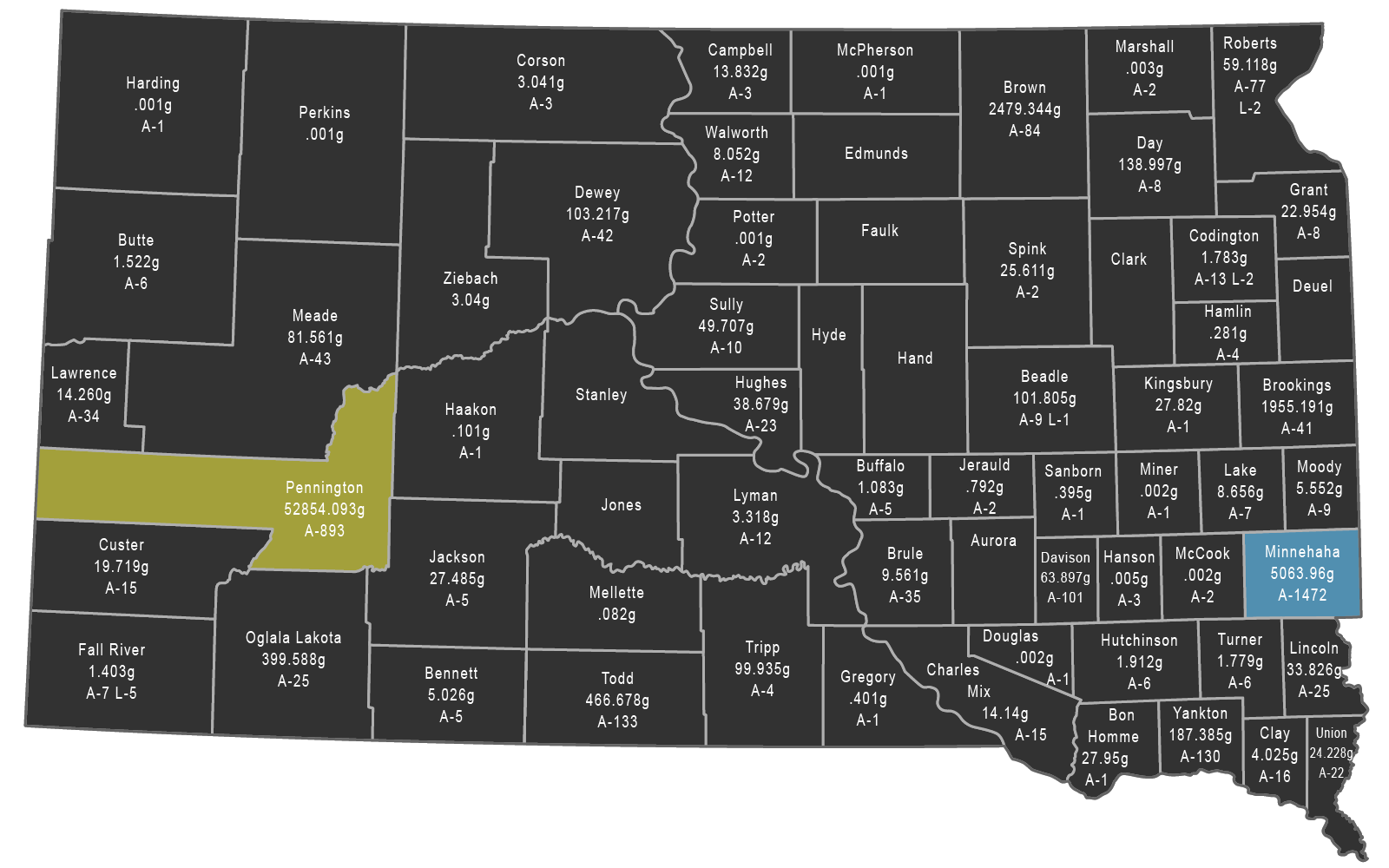What is methamphetamine?

Methamphetamine is a stimulant drug usually used as a white, bitter-tasting powder or a pill. Crystal methamphetamine is a form of the drug that looks like glass fragments or shiny, bluish-white rocks. It is chemically similar to amphetamine [a drug used to treat attention-deficit hyperactivity disorder (ADHD) and narcolepsy, a sleep disorder].
Other common names for methamphetamine include chalk, crank, crystal, ice, meth, and speed.
How is methamphetamine used~
People can take methamphetamine by: inhaled/smoked, swallowed (pill), snorted, inject the powder that has been dissolved in water/alcohol
Methamphetamine effects on the brain~
Methamphetamine increases the amount of the natural chemical dopamine in the brain. Dopamine is involved in body movement, motivation, pleasure, and reward (pleasure from natural behaviors such as eating). The drug’s ability to release high levels of dopamine rapidly in reward areas of the brain produces the “rush” (euphoria) or “flash” that many people experience.
Short-Term Effects~
Taking even small amounts of methamphetamine can result in many of the same health effects as those of other stimulants, such as cocaine or amphetamines.
- Increased wakefulness and physical activity
- Decreased appetite
- Faster breathing
- Rapid and/or irregular heartbeat
- Increased blood pressure and body temperature
Long-Term Effects~
People who inject methamphetamine are at increased risk of contracting infectious diseases such as HIV and hepatitis B and C. These diseases are transmitted through contact with blood or other bodily fluids. Methamphetamine use can also alter judgment and decision-making leading to risky behaviors, such as unprotected sex, which also increases risk for infection. Long-term methamphetamine use has many other negative consequences.
- Extreme weight loss
- Severe dental problems
- Intense itching, leading to skin sores from scratching (meth mites, crank bugs)
- Anxiety
- Confusion
- Sleeping problems
- Violent behavior
- Paranoia—extreme and unreasonable distrust of others
- Hallucinations—sensations and images that seem real though they aren’t
The methamphetamine addiction~

Methamphetamine is highly addictive. When people stop taking it, withdrawal symptoms can include:
- Anxiety
- Fatigue
- Severe depression
- Psychosis
- Intense drug cravings
Drug Crime in South Dakota~
- Drug Crime Arrests are the number one prosecuted criminal offense in South Dakota
- Drug Crime affects all elements of our State. Individuals, families, schools, businesses
- Drug Crime affects all ages of our population
- Drug Crime can play a role in violent crime
Methamphetamine stats at a glance~


L = Lab Incidents Reported
742 Arrests
2701.214 grams of meth
806 Arrests
8918.938 grams of meth
1139 Arrests
17227.58 grams of meth

L = Lab Incidents Reported
893 Arrests
52854.093 grams of meth
1025 Arrests
6538.799 grams of meth
1472 Arrests
5063.97 grams of meth
South Dakota Statutes~
13-32-9. Suspension from extracurricular activities for controlled substances violation–Unified Judicial System to give certain notices.
Any person adjudicated, convicted, the subject of an informal adjustment or court-approved diversion program, or the subject of a suspended imposition of sentence or suspended adjudication of delinquency for possession, use, or distribution of controlled drugs or substances or marijuana as defined in chapter 22-42, or for ingesting, inhaling, or otherwise taking into the body any substances as prohibited by § 22-42-15, is ineligible to participate in any extracurricular activity at any secondary school accredited by the Department of Education for one calendar year from the date of adjudication, conviction, diversion, or suspended imposition of sentence. The one-year suspension may be reduced to thirty calendar days if the person participates in an assessment with a certified or licensed addiction counselor. If the assessment indicates the need for a higher level of care, the student is required to complete the prescribed program before becoming eligible to participate in extracurricular activities.
.......Read More
Upon placement of the person in an informal adjustment or court-approved diversion program, the state’s attorney who placed the person in that program shall give notice of that placement to the South Dakota High School Activities Association and chief administrator of the school in which the person is participating in any extracurricular activity.
As used in this section, the term, extracurricular activity, means any activity sanctioned by the South Dakota High School Activities Association. Students are ineligible to participate in activity events, competitions, and performances, but a local school district may allow a student to participate in practices.
Source: SL 1997, ch 102, §§ 1, 4; SL 2003, ch 272 (Ex. Ord. 03-1), § 63; SL 2006, ch 82, § 1; SL 2010, ch 92, § 1; SL 2014, ch 88, § 1.
See Less
13-32-9.2. Reduced suspensions–Minimum requirements–Commencement of suspension.
If a suspension is reduced pursuant to § 13-32-9, a suspension for a first offense shall make the student ineligible for a minimum of two South Dakota High School Activities Association sanctioned events. If two sanctioned events for which the student is ineligible do not take place within the reduced suspension period, the student’s suspension remains in effect until two sanctioned events for which the student is ineligible have taken place. If a suspension is reduced pursuant to § 13-32-9, a suspension for a second offense shall make the student ineligible for a minimum of six South Dakota High School Activities Association sanctioned events. If six sanctioned events for which the student is ineligible do not take place within the reduced suspension period, the student’s suspension remains in effect until six sanctioned events for which the student is ineligible have taken place.
.......Read More
- The day following the notification to a school administrator by the Unified Judicial System that a student has been adjudicated, convicted, the subject of an informal adjustment or court approved diversion program, or the subject of a suspended imposition of a sentence or a suspended adjudication of delinquency for possession, use, or distribution of controlled drugs, substances, or marijuana as defined in chapter 22-42, or for ingesting, inhaling, or otherwise taking into the body any substance prohibited by § 22-42-15 and the school administrator gives notice to the South Dakota High School Activities Association and the students; or
- The day following the student’s admission to a school administrator that the student committed an offense enumerated in subdivision (1), which shall be made with the student’s parent or guardian present if the student is an unemancipated minor, and the school administrator gives notice to the South Dakota High School Activities Association.
See Less
26-8B-6. Decree of disposition–Contents–Findings.
.......Read More
- The court may place the child on probation pursuant to § 26-8B-8 or under protective supervision in the custody of one or both parents, guardian, custodian, relative, or another suitable person under conditions imposed by the court;
- The court may require as a condition of probation that the child participate in a supervised community service program, provided the child is not placed in a detention facility and is not deprived of the schooling that is appropriate to the child’s age, needs, and specific rehabilitative goals. The supervised community service program shall be of a constructive nature designed to promote rehabilitation, shall be appropriate to the age level and physical ability of the child, and shall be combined with counseling by a court services officer or other guidance personnel. The supervised community service program assignment shall be made for a period of time consistent with the child’s best interests, but may not exceed ninety days;
- If the court finds that the child has violated a valid court order, the court may place the child in a detention facility for not more than ninety days, which may be in addition to any period of temporary custody, for purposes of disposition if:
- The child is not deprived of the schooling that is appropriate for the child’s age, needs, and specific rehabilitative goals;
- The child had a due process hearing before the order was issued; and
- A plan of disposition from a court services officer is provided to the court;
- The court may require the child to pay restitution, as defined in subdivision 23A-28-2(4) and under conditions set by the court if payment can be enforced without serious hardship or injustice to the child;
- The court may place a child in an alternative educational program;
- The court may order the child to be examined and treated at the Human Services Center;
- The court may impose a fine not to exceed five hundred dollars;
- The court may order the suspension or revocation of the child’s right to apply for a driving privilege, suspend or revoke an existing driving privilege, or restrict the privilege in such manner as the court sees fit or as required by § 32-12-52.4, including requiring that financial responsibility be proved and maintained;
- The court may assess or charge the same costs and fees as permitted by §§ 16-2-41, 23-3-52, 23A-27-26, 23A-28B-42, and 23A-27-27 against the child, parent, guardian, custodian, or other party responsible for the child; or
- The court may only commit a child to the Department of Corrections if the judge finds that:
- No viable alternatives exist;
- The Department of Corrections is the least restrictive alternative; and
- The court finds from evidence presented at the dispositional hearing or from the pre-dispositional report that the youth presents a significant risk of physical harm to another person.
Any finding made pursuant to this section shall be made in the written decree.
After disposition, but prior to placement in a juvenile correctional facility, a state interagency team comprised of representatives from the Department of Human Services, the Department of Social Services, the Department of Education, the Department of Corrections, and the Unified Judicial System shall make a written finding that placement at a Department of Corrections facility is the least restrictive placement commensurate with the best interests of the child. Subsequent placement in any other Department of Corrections facility may be authorized without an interagency review.
No adjudicated child in need of supervision may be incarcerated in a detention facility except as provided in subdivision (3) or (10) of this section.
Source: SDCL 1939, § 43.0319 as enacted by SL 1968, ch 164, § 13; SL 1973, ch 171; SL 1974, ch 179, § 8; SL 1982, ch 200, § 3; SL 1990, ch 196, § 2; SDCL §§ 26-8-39.2, 26-8-40.1; SL 1991, ch 217, § 147B; SDCL § 26-8-39.2; SDCL Supp, § 26-8-40.1; SL 1994, ch 219, § 6; SL 1995, ch 151; SL 1996, ch 172, § 19; SL 1996, ch 180; SL 1998, ch 163, § 2; SL 2000, ch 123, § 1; SL 2001, ch 143, § 1; SL 2003, ch 149, § 6; SL 2003, ch 272 (Ex. Ord. 03-1), § 63; SL 2004, ch 182, § 1; SL 2005, ch 120, § 129; SL 2007, ch 163, § 3; SL 2008, ch 139, § 2; SL 2015, ch 152, § 29, eff. Jan. 1, 2016; SL 2016, ch 146, § 7, eff. Mar. 25, 2016.
See Less
26-8B-7. Limit of temporary custody.
An alleged or adjudicated child in need of supervision may not be held in temporary custody for more than ninety days beginning with the date the child is first taken into custody unless at the ninetieth day the child is in the process of receiving treatment or care which has a specified duration. In that case the temporary custody may be extended to the end of the treatment or care.
26-8C-7. Decree of disposition–Contents–Findings.
If a child has been adjudicated as a delinquent child, the court shall enter a decree of disposition according to the least restrictive alternative available in keeping with the best interests of the child. The decree shall contain one or more of the following:
.......Read More
- The court may require the child to pay restitution, as defined in subdivision 23A-28-2(4) and under conditions set by the court, if payment can be enforced without serious hardship or injustice to the child;
- The court may impose a fine not to exceed one thousand dollars;
- The court may place the child on probation under the supervision of a court services officer or another designated individual pursuant to § 26-8C-14;
- The court may require a child as a condition of probation to participate in a supervised community service program, if the child is not deprived of the schooling that is appropriate for the child’s age, needs, and specific rehabilitative goals. The supervised community service program shall be of a constructive nature designed to promote rehabilitation, appropriate to the age level and physical ability of the child, and shall be combined with counseling by the court services officer or other guidance personnel. The supervised community service program assignment shall be made for a period of time consistent with the child’s best interests, but for not more than ninety days;
- The court may place the child at the Human Services Center for examination and treatment;
- The court may place the child in a detention facility for not more than ninety days, which may be in addition to any period of temporary custody;
- The court may place the child in an alternative educational program;
- The court may order the suspension or revocation of the child’s right to apply for a driving privilege, suspend or revoke an existing driving privilege, or restrict the privilege in such manner as it sees fit, including requiring that financial responsibility be proved and maintained;
- The court may assess or charge costs and fees permitted by §§ 16-2-41, 23-3-52, 23A-27-26, 23A-28B-42, and 23A-27-27 against the child, parent, guardian, custodian, or other party responsible for the child; or
- The court may only commit a child to the Department of Corrections if the judge finds that:
- No viable alternative exists;
- The Department of Corrections is the least restrictive alternative; and
- The child is currently adjudicated delinquent for an offense eligible for transfer proceedings pursuant to § 26-11-3.1; the child is currently adjudicated delinquent for a crime of violence pursuant to subdivision 22-1-2(9), sex offense pursuant to § 22-24B-1, felony sexual registry offense pursuant to chapter 22-24B, or burglary in the second degree pursuant to § 22-32-3; or the court finds from evidence presented at the dispositional hearing or from the pre-dispositional report that the youth presents a significant risk of physical harm to another person.
Any finding made pursuant to this section shall be made in the written decree.
See Less
26-8B-8. Terms and conditions of probation
Duration–Written statement and explanation required–Review–Release–Modification. The terms and conditions of probation of a child in need of supervision shall be specified by rules or orders of the court and by a court services officer.
The duration of juvenile probation shall be specified by order of the court but may not exceed four months unless:
.......Read More
- The child is placed in the intensive juvenile probation program; or
- The child’s probation is extended as provided under this section.
If the child is placed on intensive juvenile probation, the duration of probation ordered by the court may be up to eight months.
If the child is placed on juvenile probation, a court services officer may request two extensions up to four months each or one extension up to four months for intensive juvenile probation. The court may authorize the same in accordance with Unified Judicial System procedure if the extension is necessary for the child to complete evidence-based treatment as required by the case plan. If evidence-based treatment is not available, an extension may be granted if the youth is engaged in alternative court-approved treatment that will not be completed before the previously ordered term of probation expires.
The total duration of probation, including juvenile intensive probation and extensions in all cases, may not exceed twelve months unless the court provides written authorization to allow a child to complete evidence-based treatment that will not be completed before probation expires. Probation may not be extended solely to collect restitution. If probation is terminated with restitution owing, Unified Judicial System procedure may govern the collection.
Each child placed on probation shall be given a written statement of the terms and conditions of probation and the probation policy. The terms and conditions, as well as the probation extension policy, shall be explained to the child.
The court shall review the terms and conditions of probation and the progress of each child placed on probation at least once every four months. The court may release a child from probation or modify the terms and conditions of the child’s probation at any time, but any child who has complied satisfactorily with the terms, conditions, and duration of probation shall be released from probation and the jurisdiction of the court terminated. If the duration of probation previously prescribed has expired, the court shall release the child from probation and terminate jurisdiction.
See Less
32-12-52.4. Suspension for certain alcohol-related offenses by a minor.
Upon a first conviction or a first adjudication as a child in need of supervision for a violation of § 35-9-2 while in a vehicle, the court shall suspend the driver license or driving privilege of the driver, if the driver was under the age of twenty-one when the offense occurred, for a period of thirty days.
Upon a second conviction or a second adjudication as a child in need of supervision for a violation of § 35-9-2 while in a vehicle, the court shall suspend the driver license or driving privilege of the driver, if the driver was under the age of twenty-one when the offense occurred, for a period of one hundred eighty days.
.......Read More
Upon a third or subsequent conviction or a third or subsequent adjudication as a child in need of supervision for a violation of § 35-9-2 while in a vehicle, the court shall suspend the driver license or driving privilege of the driver, if the driver was under the age of twenty-one when the offense occurred, for a period of one year. For any offense under this section, the court may issue an order, upon proof of financial responsibility pursuant to § 32-35-43.1, permitting the person to operate a vehicle for purposes of the person’s employment, attendance at school, or attendance at counseling programs.
Notwithstanding the provisions of chapters 26-7A, 26-8A, 26-8B, and 26-8C, the Unified Judicial System shall notify the Department of Public Safety of any conviction or adjudication for a violation, while in a vehicle, of § 35-9-2 or chapter 32-23. The period of suspension begins on the date the person’s suspended driver license is received by the court or the Department of Public Safety. At the expiration of the period of suspension, a person may make application to have the license reinstated and pay the license fee as prescribed in § 32-12-47.1.
Source: SL 1990, ch 250, § 1; SL 1991, ch 252, § 22; SL 1991, ch 255; SL 1992, ch 217, § 2; SL 1994, ch 219, § 7; SL 1994, ch 253; SL 1994, ch 255, § 4; SL 1996, ch 179, § 4; SL 2001, ch 171, § 53; SL 2001, ch 173, § 2; SL 2001, ch 174, § 1; SL 2003, ch 149, § 11; SL 2003, ch 272, § 23; SL 2006, ch 165, § 2.
See Less
32-23-1. Driving or control of vehicle prohibited with alcohol in blood or while under influence of alcohol, drug, or intoxicant.
.......Read More
- There is 0.08 percent or more by weight of alcohol in that person’s blood as shown by chemical analysis of that person’s breath, blood, or other bodily substance;
- Under the influence of an alcoholic beverage, marijuana, or any controlled drug or substance not obtained pursuant to a valid prescription, or any combination of an alcoholic beverage, marijuana, or such controlled drug or substance;
- Under the influence of any controlled drug or substance obtained pursuant to a valid prescription, or any other substance, to a degree which renders the person incapable of safely driving;
- Under the combined influence of an alcoholic beverage and or any controlled drug or substance obtained pursuant to a valid prescription, or any other substance, to a degree which renders the person incapable of safely driving; or
- Under the influence of any substance ingested, inhaled, or otherwise taken into the body as prohibited by § 22-42-15.
Source: SDC 1939, §§ 44.0302, 44.9920, 44.9922; SL 1949, ch 42, § 1; SL 1953, ch 246, § 1; SDC Supp 1960, § 44.0302-1; SL 1973, ch 195, § 3; SL 1976, ch 158, § 42-8; SL 1982, ch 246, § 1; SL 2002, ch 160, § 1; SL 2006, ch 168, § 1.
See Less
32-23-21. Driver under age of twenty-one operating vehicle after alcohol or drug consumption
.......Read More
- If there is physical evidence of 0.02 percent or more by weight of alcohol in the person’s blood as shown by chemical analysis of the person’s breath, blood, or other bodily substance; or
- After having consumed marijuana or any controlled drug or substance for as long as physical evidence of the consumption remains present in the person’s body.
If a person is found guilty of or adjudicated for a violation of this section, the Unified Judicial System shall notify the Department of Public Safety. Upon conviction or adjudication, the court shall suspend that person’s driver’s license or operating privilege for a period of thirty days for a first offense, one hundred eighty days for a second offense, or one year for any third or subsequent offense. However, the court may, upon proof of financial responsibility pursuant to § 32-35.43.1, issue an order permitting the person to operate a vehicle for purposes of the person’s employment, attendance at school, or attendance at counseling programs.
Source: SL 1998, ch 198, § 1; SL 1999, ch 165, § 1; SL 2003, ch 272, § 23; SL 2004, ch 218, § 1; SL 2006, ch 165, § 4.
See Less